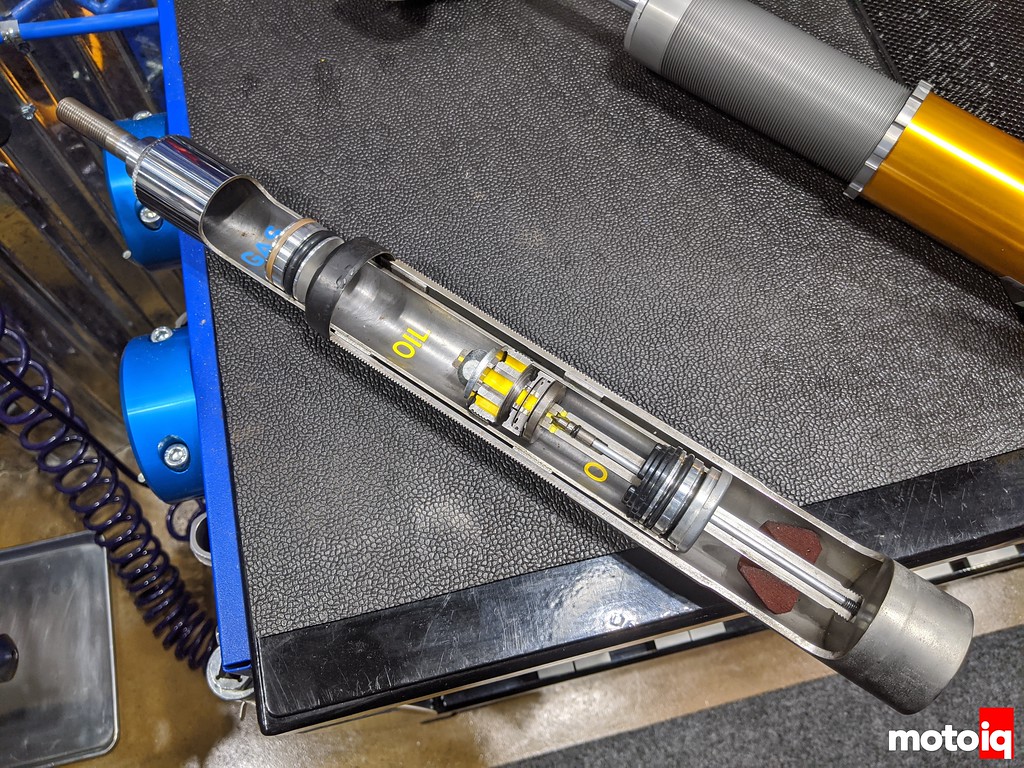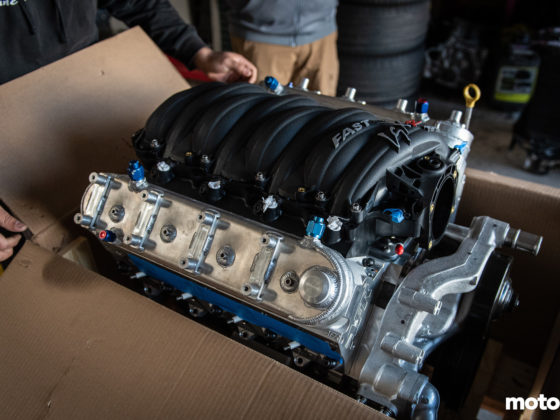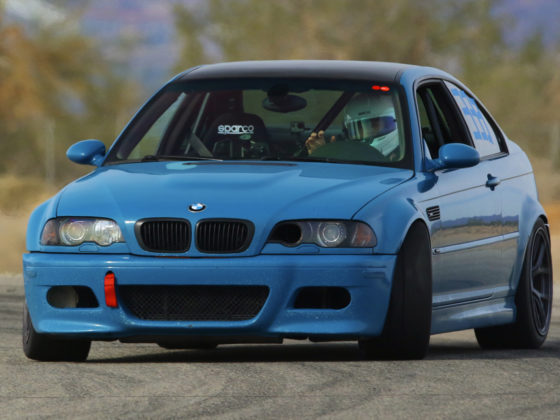
A few weeks ago we were visiting the North American facilities of Ohlins Advanced Suspension Technology, Ohlins USA for a special look inside Ohlins’ operations and to be able to get a close look at some of their technology. We are sure that most of you MotoIQ readers are very familiar with the Ohlins name and associate it with high-end professional motorsports from IMSA and Indy cars to Moto GP and Supercross, but Ohlins also makes many consumer affordable suspension systems for high-performance street and dual-purpose street/track cars.
Their main offering in this market segment, the Ohlins DFV line of coilovers and MacPherson struts, impressed us with the quality of manufacturing and some very unique technical features that set the product line apart in the market. The main technical feature of this lineup is the DFV or Dual Flow valve. The Dual Flow Valve is Ohlins’ answer to make a conventional deflected disc valve system more sensitive and faster reacting to high-frequency ripple and square-edged bumps. This type of bump often causes tire shock, a loss of traction and ride discomfort. The DFV valve is good at absorbing these kinds of road shocks without affecting low-speed control. Low-speed control helps keep roll, squat, dive at bay and helps sharpen transient response which is critical for a performance car. Many times, a shock that is good at controlling platform movement does poorly at providing comfort and traction finding suppleness over small bumps. The DFV valve is designed to be the best of both worlds, an absorbent supple shock that controls body movement well. How does the DFV valve work? Let’s take a look.

In this cutaway picture of the DFV valve, figure 1 is the compression stroke. Under low-speed conditions which is 0-1.5 inches per second of shaft velocity, fluid mostly flows through the hollow shock shaft through a metering orifice whose flow volume is determined by an adjusting needle valve. After passing through the needle valve the low-speed circuit fluid flows out of an orifice in the side of the shock shaft to the other side of the shock piston. You can see the low-speed flow indicated by the dotted line going through the shaft. At higher shaft velocities the fluid flow volume increases and to keep up with the flow demand, the fluid backing up behind the piston travels through holes in the piston where the pressure must overcome and bend the stack of stainless steel shims blocking the holes. This is your high-speed compression circuit. The high-speed circuit is activated when you hit a bump or strike an FIA curb and helps your suspension react to larger bumps. How the high-speed circuit reacts is controlled by size, shape, diameter, and number of holes in the piston and by the diameter, thickness and stacking sequence of the shims blocking the holes. Typically these can be tuned really well to a car’s weight, tire type, and suspension motion ratio.
Now there is a zone in the mid to mid high speed of shaft velocities and higher frequencies where a high-speed circuit that is calibrated to prevent a car from blowing through its travel isn’t so sensitive, a lot of this is due to the amount of fluid flow needed to bend the high-speed shim stack. This causes some lag in the high-speed circuit’s response. This is where the DFV comes into play. In the DFV shock, there is another fluid flow path, hence dual flow. Fluid flowing through the shock shaft can flow through another orifice in the shaft, before the needle valve, leading to a second valve and another set of shims. This second set of shims is set up to be softer and quicker responding and gives the DSV shock good compression responsiveness.
On the rebound side of things, as shown in the dotted lines in figure 2, at low shafts speeds, the fluid flows through holes in the shaft and past the needle valve to the other side of the piston. At higher speeds, the shims blocking holes in the piston deflect and allow fluid to flow through the piston just like on the compression side. At mid speeds, or during the piston valve’s lag time, fluid can flow through the shaft before the needle valve to the softly shimmed DFV valve.

Here is a cutaway DFV strut. It is a strong inverted shaft design. We wrote about how an inverted shaft strut works last week, so be sure to read that article. The DFV strut is of monotube construction with a gas chamber at one end where the gas is separated from the fluid by a floating piston.

The DFV valve is the one that the finger is pointing at, behind the main piston. You can see how the shims on the DFV piston are thin for quick response compared to the shim stack on the main piston. You can see the flow passages painted yellow. You can see the damping adjustment needle valve in the center of the shaft. The damping adjustment affects the low-speed rebound mostly although it is a global adjustment.




13 comments
Õhlins is really trick stuff. I remember from repairing and doing maintenance on them a few years back.
The TPX/TTX Rally struts are really something else.
Twin-piston, 2-way compression, low-speed rebound adjustment and additionally You could adjust how hard it bottoms out.
Õhlins calls it Progressive Damping System. It comprises a small short cylinder at the top of the strut and a small piston at the end of the shaft.
Basically, You could call it a triple-piston strut.
Huh, OK… so if I’m picturing this correctly (I’m making guesstimates at the DFV piston port design from the shims) what you end up with is a pretty steep force vs velocity plot at low speed where it’s just the needle valve flowing, then the DFV valves blow off like a digressive piston to soften “mid” velocity, then eventually the port to/from the DFV chokes and it’s working through the linear main stack? Kind of the opposite of the Penske digressive blowoff option where it’s needle/main stack/added valve; probably a much lower speed blow off. Maybe like Penske’s VDP in F/V graph shape (obviously not in mechanism)
What’s using the valving to control kerb strike motion get you? At least on racing oriented dampers, I’m seeing a lot more trickery to try to avoid high speed force, though obviously that’s going to be application specific. This is not me trying to launch into an Ohlins vs Whoever Else argument – that’s a cool tuning tool, I’m just wondering why you’d want it on track.
That’s exactly how it works. A lot of buzz nowadays is getting a regressive or at least a leveling off compression curve to handle those curb hits. That’s the 5th adjustment of the newer 5-way shocks. Not sure if this is really what our sedan based cars need but I can see it as valuable with lighter cars. I need to work on a car with this and get some experience.
I’m working on an SCCA GT-3 car for the next race car, so suddenly shocks get easier when they’re 1/2″ rod ends on either end. Doing a lot of thinking about shocks lately, as I don’t see why revalved circle track Bilsteins wouldn’t be a horrible place to start – not optimal but cheap.
Actually, have access to some weird stuff at work now – playing with a bunch of servohydraulics. Seriously thinking of doing a quarter car model on some vertical sliders, putting it on top of one of the actuators, weighting it accurately, and running sine sweeps or other things to look at transmissibility. Not as ideal as a real 4-post rig, but the price is right.
I’ve been looking tho get a set of these since there came out here in Japan where I live, sadly the lack of users and reviews made me hesitant. Tho there’s a popular “myth” here in Japan where it is Ohlins that makes HKS coilovers (Hypermax IVs at least). It was either Ohlins or RS-R for Street/ track single adjustable set that I was choosing from.
Thanks a lot for this in-depth write up Mike, you’ve educated me yet again.
Ohlins R&T are made in Japan. The more expensive TTX line is made in Sweden. Not sure about the HKS coilovers, but the R&Ts on my WRX came with rebranded Cusco top hats.
I was luck enough to find a used set of Ohlins for my CL9 Acura TSX/Honda Accord. They were built with some crazy low ride height and crazy high spring rates (24kg/mm fronts). I have since spoken to Ohlins USA and got inserts and more reasonable spring rates and I must say the ride is very very impressive (coming from ground control/koni set up. Great write up and I appreciate the MotoIQ team going the technical route.
How different is this from Koni FSD?
I am not sure never seen one of those apart.
Koni FSD does something completely different. It uses a second set of bypass valves that basically makes the dampers not work unless you stroke them a certain distance. It’s a very clever implementation of stroke-sensitive damping but it’s a nightmare to tune.
Great for ride comfort on the street if you use stock springs, but a fairly useless feature for racecars and tuned street cars.
Do you have a link to how the parts are? I am pretty sure they are not position sensitive butI have never seen a picture of them.
I have a 2002 Nissan Sentra Spec V. A V6VQ manual installed..ABS NOT functioning..do I need. Maxima ECU module or wire harnees to replace Spec V?? Also have 300 Z front calipers..stops well with G Loc 12’s..HELP PLS?
I had an Electraglide with the heavy duty harley shocks on it that were still rubbish and I ordered Ohlins fork inserts and there rear shocks and springs and it still handled the same but the ride was transformed very supple but extremely progressive, all I’m really saying is that these guys know what there doing. Thanks Michael.